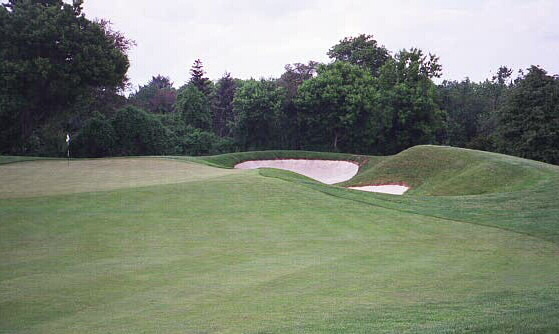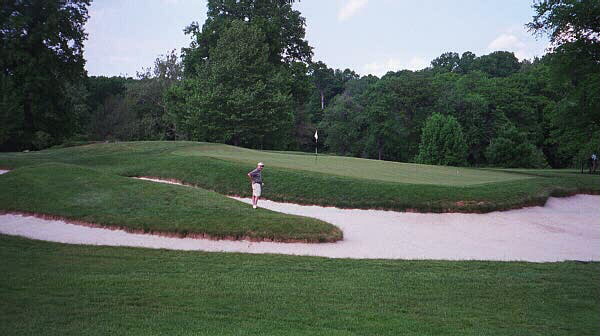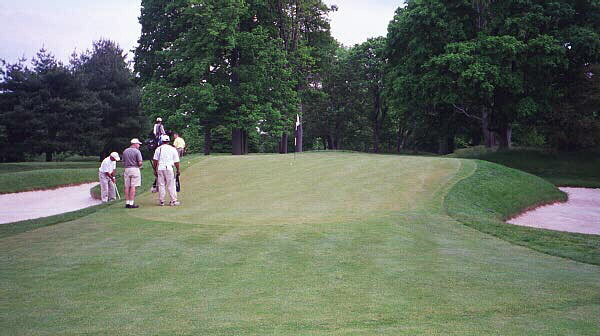Fenway Golf Club
New York, United States of America

Tillinghast’s orginial Sahara bunker complex on the 3rd hole has only recently been recovered. The severe ridge in the distant green is visible even from here.
Is Fenway A.W. Tillinghast’s finest design?
What! How can that be, you ask? Fenway hasn’t hosted the U.S. Open like the Winged Foot or Baltusrol or a Walker Cup like Quaker Ridge or Five Farms. Nor has it the fearsome, worldwide reputation as Bethpage Black. In addition, Fenway has never attracted the cult following of either Somerset Hills or San Francisco Golf Club.
So how can Fenwway even be considered in the same league?
Part of the answer lies in its origins – Fenway was always meant to be the equivalent (or better) of its nearby neighbors Winged Foot and Quaker Ridge. In 1922, the Club hired Devereux Emmet to design an 18 hole course on the old James Fenimore Cooper estate but within 18 months, it was evident that the course was no comparison for its illustrious neighbors. The founding members of the club had no interest in being third best, so the course was closed and Tillinghast was contacted. His marching orders aren’t as famous as those at Winged Foot but the point was clear: build us the very best course that you can. To accomplish that, Tillinghast was given 240 acres, the topography of which was more rolling and varied than either course at Winged Foot.

The downhill 10th is an example of the topography with which Tillinghast was fortunate to work.
The Tillinghast course opened to rave reviews, and from 1925 until 1929, was considered the equal of any in this golf rich area. In relation to its design merits, Gil Hanse in his Feature Interview on this site said the following:
The course has some wonderful rolling ground, a few rock outcroppings, and a great variety of golf holes. Tillinghast used the ground magnificently and the round of golf incorporates all facets of the game. However, it is the green complexes that make this course so special: they are an eccentric bunch, featuring some of the most incredible raised plateau greens, and deep bunkers. They range in variety from the roller coaster 3rd, to the fiendishly sloping 7th. In size the 18th green is well over 10,000 square feet, and the short par 4 15th green is barely 2,500 square feet. This variety is a great asset, but it is truly the putting contours themselves that merit a close study to appreciate the fine art of green construction.
However, beginning with the Great Depression, the club fell on hard times and never regained the same spotlight. Fortunately, the club’s fortunes began to change for the better in the late 1990s. Spurred on by Green Chairman Steve Frankel, the board hired Gil Hanse to restore properly every bunker andreturn allthe greens to their original sizes. In the process, Hanse brought back twenty-to bunkers that had been filled in over time and expanded the greens by over 13,000 square feet. In addition, some limited tree removal was undertaken.
The end result is astonishing. The days of Fenway not being recognized amongst Tillinghast’s most impressive designs are over. Given the restoration’s success, it is important to understand what made it so.
First, the golfer never realizes that Hanse & Co. were ever here. Though associate Rodney Hine was the on-site man, the course remains a Tillinghast. Rather than second guess Tillinghast, Hanse and Hine carefully researched all available old documents and aerial photos. They uncovered plenty of material and through this research, the need for interpretation was minimized. Thus, the end product is as pure to the original architect’s intent as possible.

The bold green and bunker contours throughout the course (seen here is the 14th) only further confirm the design flair that Tillinghast possessed.
Secondly, the club was fortunate in that they were able to hirethe long time Green Keeper from Winged Foot Bob Alonzi. Already intimately familiar with Tillinghast’s work, Alonzi’s work ethic and belief in firm and fast playing conditions made it a certainty that the course would be presented in an ideal manner.
Thirdly, the board put their full trust in Hanse and with a strong Green Chairman pushing events through in a timely manner, the project was destined for success.
Holes to Note
Second hole, 455 yards; Of all of Tillinghast’s courses, Fenway may best highlight the options for a ground game. Time after time, the golfer finds that running his approach onto the green is the ideal play. With the 2nd back tee having been recaptured and thus extending the hole 60 yards, most golfers will be be left with a long iron approach with the key being to use the open ground in front of the green to one’s advantage.
Third hole, 525 yards; A great course must have great holes and the 3rd at Fenway counts as a great three shotter. This hole has two attributes that Tillinghast much admired in his long holes: a Sahara bunker complex (as found on the 17th at Baltustol Lower and the 14th at Five Farms in Baltimore) and the use of out of bounds (as found on the 6th hole at Five Farms). Many of the great master architects considered out of bounds as the ultimate test for a golfer and thus a course like Royal Liverpool has always been highly regarded (when asked if Hoylake was the finest in England, Tom Simpson replied, ‘Without any doubt.’) However, as Hanse notes, in this day of public liability, such design philosophy is all but obselete and indeed the trees in the picture below are now meant to steer the golfer away from the out of bounds on his second shot.

From behind the 3rd green, the golfer sees how Tillinghast originally wanted the golfer to flirt with the out of bounds along the left to gain the best angle into the green. From the far left hand side, the 2 1/2 foot ridge in the green provides the perfect backstop for getting the pitch close to this hole location.
Fourth hole, 145 yards; Though two of the other three one shotters at Fenway are more monstrously difficult, this one has the most charm. Yet just because it is in easy reach of all levels of player, the severe green contours easily extract three putts from all those who don’t hit the proper portion of the green.

The back shelf on the 4th green demands a precise iron.
Fifth hole, 460 yards; Hanse recovered the bunkers both left and right off the tee, so nowthe hole plays from tee to green as Tillinghast intended. However, the real showpiece is the green. Set into the hillside that eventually leads tothe clubhouse, the green ressemblesa wave as it rolls up to the back. Hanse recaptured five feet of perimeter green along the high back right side and the golfer can now use that area to work the ball closer to certain hole locations. Indeed, the membership has come to appreciate that the course is more enjoyable – rather than harder – to play with the greens backto their original size.

The four newly restored bunkers protect the inside of the dogleg 5th while…

…these (which are shared with the 3rd hole) guard the outside.

The ball just beyond the flagstick was once within a foot of the right collar before feeding back to the hole.

Given the swift pace of the greens, the five foot back to front drop on the 5th green is guaranteed to give the careless golfer fits.
Eighth hole, 355 yards and twelfth hole, 455 yards; These holes parallel each other, have a similar right to left bend to their fairways, and their greens are beside one another and share a bunker complex. Otherwise, they play as differently as two holes can!

The 8th green is fronted by this unique bunker complex which is also shared with the 12th green.

Looking across the 12th green complex over to the 8th. Typical of the long two shotters, the 12th green is open in front.
Ninth hole, 400 yards; Once Tillinghast found this natural shelf green, the rest fell into place.

The 9th green is well defended.
Tenth hole, 450 yards; Tree removal has turned this into a striking hole, with the ground game again being of paramount importance: can the golfer carry a pair of bunkers 100 yards shy of the green and have his ball chase onto the open green? Tillinghast was a great admirer of links golf so it comes as no surprise to see him incorporate this attractive dilemma into his design.

Once past this pair of bunkers, the 10th green is open in front.
Thirteenth hole, 410 yards; The Cape green, which is angled from front right to back left, makes this one of the more interesting uphill approach shots that the golfer will find. To be sure, the green is wide open in front, and a drawn approach will use the slope of the ground perfectly to work back to certain hole locations.
Fourteenth hole, 435 yards; The boldness of the green complex is not out of some text book but rather took plenty of flair and imagination, traits that Tillinghast enjoyed more than almost any architect, dead or alive.

The green is open for twenty yards in front if only the golfer can carry this serpentine bunker.
Fifteenth hole, 300 yards; After the beating administered from the 10th through the 14th hole, Tillinghast throws this little gem into the mix. Similar to the 11th at Country Club of Charleston, to miss the green left or right is to court a big number and many of the finest amateurs keep their approach shots short and straight in hopes for a chip and a putt par.

The golfer struggled mightily from this greenside bunker just to get a bogey.

Best to approach the tiny 2,500 sq.ft. 15th green from head on.
Sixteenth hole, 430 yards; The only hole on the course where both the tee ball and approach shot are downhill, the last forty yards of the fairway feeds directly onto the green, which is ringed by mean spirited, little bunkers.

Gauging where to land your approach on the downsloping fairway takes some local knowledge.
Eighteenth hole, 570 yards; Just as the 290 yard 1st hole makes for an excellent start to a match, the Home hole at Fenway is equally appealing as a finishing hole as anything from an eagle to a double is possible. What makes both holes are the interior contours of their respective greens. In the case of the 18th, the green is 65 paces (!) deep and the different hole locations on certain plateaus bring each of the various greenside bunkers into play.

At over 10,000 square feet, the 18th green affords numerous interesting hole locations.
As one may gather from the above hole descriptions, within Fenway’s 6700 yards, par 70, there exists great variety. There are two potentially drivable short two shotters (the 1st and 15th) yet there are also two par fours on each side playing over 450 yards and two others over 430 yards. The one shotters range from 145 yards to 245 yards. This variety dictates a constantly changing test for the player, be it a fairway wood, long iron or tricky wedge into a demanding set of greens.
What then are the weaknesses of the course? Surely there are some? Well, maybe and maybe not. The average player may grouse that he has to hit driver to two uphill par threes but Tillinghast lived up to his own words in that he beat character into each and every hole, principally around the greens. The authors imagine that Tillinghast’s sole reservation in how the course plays today is that there are too many trees (perhaps several hundred) in play which also mask the inspired nature of the property. Some of his features like the mounds in between the 8th and 12th fairways are obscured under trees while a skyline green like the 2nd would be better showcased if the trees behind it were felled.
However, the membership deserves to enjoy the course and receive the accolades that are due to it based on Hanse’s work over the past few years. As selective tree clearing continues to show off both the rolling nature of the property and the skill of Tillinghast’s own work, the authors have no doubt that Fenway will be perceived amongst architecture students as the equal to any of Tillinghast’s designs. After all, it has the greens that make Winged Foot and Somerset Hills so special; there are no indifferent holes much in the way as the courses at Baltusrol retain such a high standard; Fenway’s topography is pleasantly rolling as at Five Farms; with only two par fives and no let-up holes, the course keeps the pressure on the golfer as at Bethpage Black; and finally, Fenway enjoys the same superb conditioning as San Francisco Golf Club. All in all, you can’t ask for more than that!
The authors wish to acknowledge and thank Dr. Geoffrey Childs for his photographs and contribution to this course profile.
The End




![The Park, West Palm (Lit 9) [2023]](https://golfclubatlas.com/wp-content/uploads/2024/12/IMG_7092-2-scaled-500x383.jpg)



